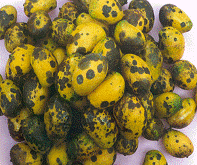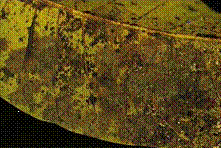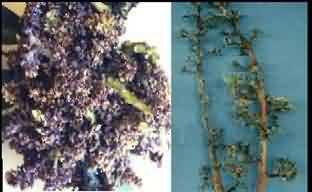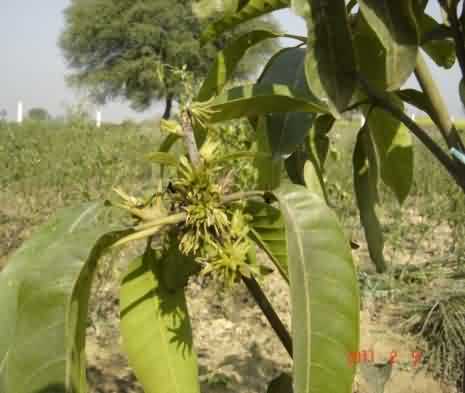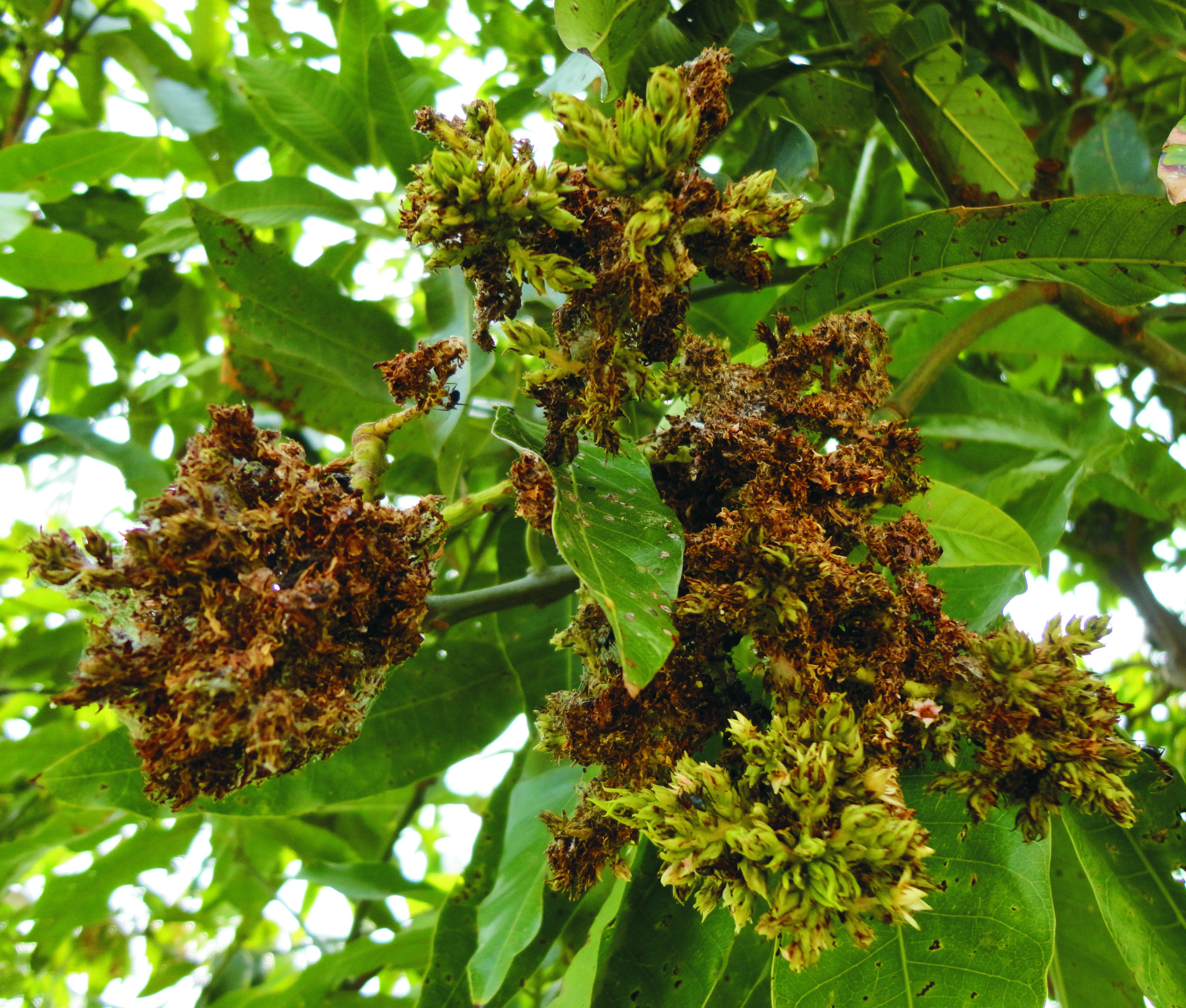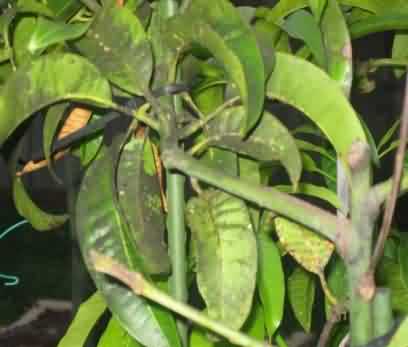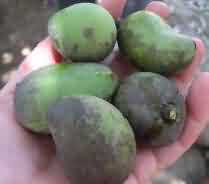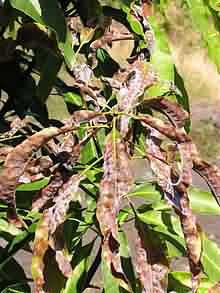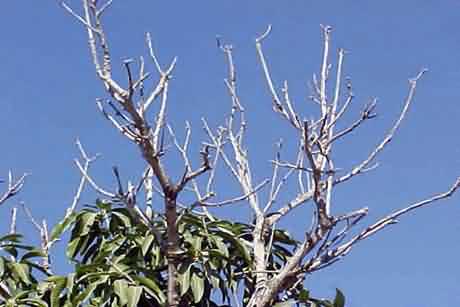आम की फसल के 6 प्रमुख रोग व उनका प्रबंधन।
Mango (Mangifera indica) is the national fruit of India, where it is known as the 'King of Fruits'. Not only is it one of the most highly prized fruits of South Asia, it is also intimately connected with folklore and legends across many religions. The mango is believed to have been discovered as long as five to six thousand years in eastern India,Thailand, Myanmar, the Andaman Islands or Malaysia.
No matter its colouring or variety, a ripe, medium size mango provides carbohydrates, fiber, vitamins A, B1, B6 and C, sodium, calcium, magnesium, zinc, copper, manganese, iron, phosphorus, potassium, pantothenic acid, and niacin.
1. Anthracnose in Mango crop: Colletotrichum gloeosporioides
Symptoms:
- Produces leaf spots, blossom blight, wither tip, twigs blight and fruit rot.
- Small blister like spots develop on the leaves and twigs. Young leaves wither and dry. Tender twigs wither and die back symptom appears.
- Necrotised tissue drop out leads to shot hole symptom
- Affected branches ultimately dry up. Black spots appear on fruits.
- The fruit pulp becomes hard, crack and decay at ripening. Infected fruits drop
Symptoms on fruits Symptoms on leaves
Management
- Spray P. fluorescens (FP 7) at 3 weeks interval commencing from October at 5g/like on flower branches.
- 5-7 sprays are to be given on flowers and bunches.
- Before storage, treat with hot water, (50-55°C) for 15 minutes or dip in Benomyl solution (500ppm) or Thiobendazole (1000ppm) for 5 minutes
- Foliar application of Carbendazim @1g/l or copper oxychloride @ 3g/l or Hexaconazole @ 1ml/l
2. Powdery mildew in Mango crop: Oidium mangiferae (Acrosporum mangiferae)
Symptoms
- It attacks the leaves, flowers, stalks of panicle and fruits.
- Dusty or white powdery growth appears on leaves.
- Shedding of infected leaves occurs when the disease is severe.
- The affected fruits do not grow in size and may drop before attaining pea size.
- Survives as dormant mycelium in affected leaves.
- Secondary spread by air borne conidia
Symptoms on leaf Symptoms on inflorescens
Management
- Dusting the plants with fine sulphur (250-300 mesh) at the rate of 0.5 kg/tree.
- The first application may be soon after flowering, second 15 days later (or) spray with Wettable sulphur (0.2%), (or) Carbendazim (0.1%),(or) Tridemorph ( 0.1%),(or) Karathane (0.1%).
3. Mango malformation in Mango crop: Fusarium moniliforme var. subglutinans
Symptoms:
Two distinct types of malformations are vegetative and floral/blossom.
- Vegetative malformation is loss of apical dominance and swelling of vegetative buds in the leaf axil or at the tip.
- The seedlings produce small shootlets bearing small, scaly leaves giving a bunch like appearance.
- Seedlings frequently sprout vegetative buds all over the internodes making withes broom like symptoms prominent.
- Vegetative buds or shoots also sprout in grown up trees where small bunches are produced at the terminals.
- Reduces number of flowers or no flowers.
- The terminals which change into bunch ultimately dry leading to death of the shoots.
- Floral malformation appears with the emergence of inflorescences where the flowers are much enlarged.
- In some cases, the flower buds never open and remain dull green.
- Branches with diseased inflorescence can produce both malformed panicles give leafy appearance unlike normal panicles.
- Malformed panicles normally do not bear and if there is fruit set in the season, it does not grow more than pea size.
- Flower buds are transformed into vegetative buds and large number of small leaves and stems, reduced internodes compacted together giving a witches broom like appearance.
Management plan:
Cultural:
- Scion sticks from infected trees should not be used.
- As soon as the disease appears, the affected terminals along with the basal 15-20 cm healthy portion should be removed or prunned and burnt.
- If more than 25 per cent affected plants, de-blossoming at bud burst stage should be done to delay the flowering.
- If the incidence is 5-25 per cent, the branches should be pruned thoroughly and when flowers emerge, malformed panicles should be removed.
Chemical:
Spray
Carbendazim 0.1 per cent to give maximum disease reduction (95 %) in Dashehari and 91.30 per cent in Chausa.
4. Mango canker/ leaf spot disease of mango: Xanthomonas campestris pv. mangiferae indicae
- On leaves, the disease first appears as a regular to angular raised small water-soaked lesions measuring 1-5 mm in dia.
- Usually crowded at the apex which increase in size and turn brown to black in colour.
- These lesions are surrounded by yellow halo initially.
- Sometimes these lesions coalesce and form large, rough and raised necrotic spots.
- In severe infections, the leaves turn yellow and drop-off.
- On leaf stalks, the cankers sometimes progress superficially along the mid rib.
- On branches, twigs and stem, the fresh lesions are water-soaked, which later become raised and dark brown with longitudinal fissures exposing the vascular tissue filled with gum which oozes out.
- Canker also appears on the flower stalks which result in dropping of the flowers and young fruits.
- On young fruits, water-soaked lesions appear which turn brown to black and gradually turn into cankers.
High temperature of 32oC coupled with high humidity and rain splash is favourable for the disease development and spread.
Management:
Cultural:
- Orchard sanitation and seedling certification.
Chemical:
- Foliar spray with Streptomycin sulphate 200 ppm @ 0.2 ml/l of water.
Resistant varieties:
- Resistant- Jahangir, Fazari and Suvernarekha
- Moderately resistant- Langra, Dashehari, Kesar, Sunder Langra and Mankurad.
5. Sooty mould disease of Mango: Meliola mangiferae Earle, Capnodium mangiferae Cke. & Brown, Capnodium ramosum Cke., Tricospermum acerinum (Syd.) Speg.
Symptoms:
- Black velvety covering on the leaf surface.
- The entire leaf surface may be covered or initially the symptoms may be present only as flakes on the leaf.
- In severe cases, the whole tree turns completely black due to the presence of mould over the entire surface of twigs and leaves.
- Under dry spell such affected leaves curl and shrivel.
The severity of infection depends on the honey dew secretions by the scale insects which provide the necessary medium for the fungal growth.
Management:
Cultural:
- Pruning of affected branches and their prompt destruction prevents the spread of the disease.
Chemical:
- Wettable sulphur (0.2 %) or Mancozeb @ 0.2% + Clorpyriphos 2ml/l at 10-15 days interval provide quite effective.
6. Die-back disease of Mango: Lasiodiplodia theobromae
Symptoms:
- Drying of twigs from top downwards, particularly in the older leaves, followed by complete defoliation giving the tree an appearance of scorching at the top.
- The onset of die-back becomes evident by discolouration and darkening of the bark near the terminals but also at several other places.
- The dark area advances and young, green twigs start withering first at the base and then extending outwards along the veins of leaf edges.
- The affected leaves turn brown and its margins roll upwards. At this stage, the twig or branch start shrivelling, dries and falls.
- On slitting internal browning in the wood tissue is observed along the long axis.
- The areas of cambium and phloem show brown discolouration and yellow gum like exudates is filled in some of the cells.
Relative humidity of about 50 per cent, temperature between 25-31o C and heavy rain are favouring the disease development.
Management plan:
Cultural:
- Selection of scion from healthy trees.
- Sterilization of the budding knife.
- Keeping the grafted plant in a relatively dry environment and gradual exposure to full sunlight are effective methods to reduce overall disease.
Chemical:
- Pruning of the diseased twigs 7-8 cm below the infection site followed by spray of Bordeaux mixture (5:5:50) or Copper Oxychloride (0.3%) are found effective in controlling the die-back disease.
Authors:
Shantamma1 and Bheemanagouda Patil 2
1Department of Plant Pathology, UAS, GKVK, Bangalore – 560 065, Karnataka
2Department of Plant Pathology, UAS,, Raichur – 584 104, Karnataka
Email:

